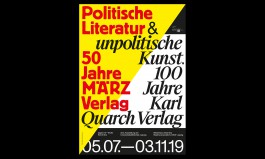
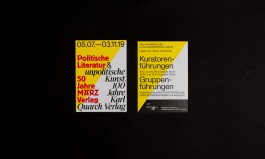
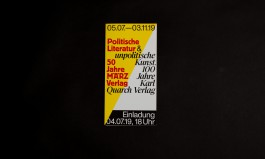
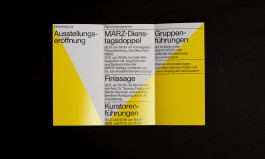

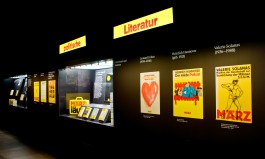
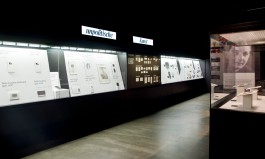
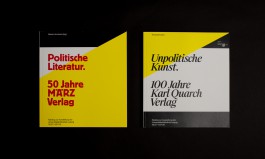
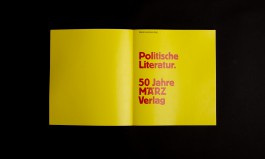
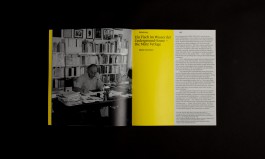
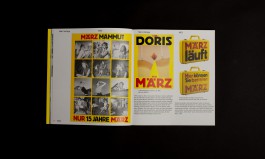
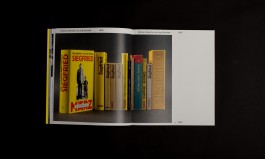
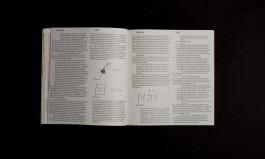
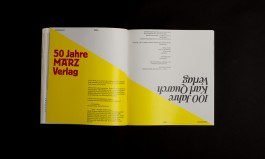
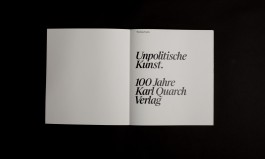
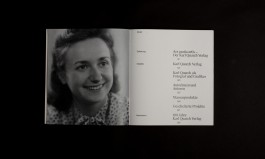
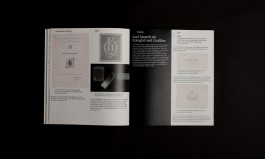
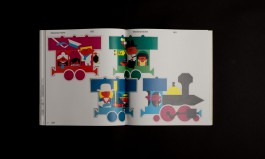

exhibition design “Politische Literatur & unpolitische Kunst. 50 Jahre MÄRZ Verlag — 100 Jahre Karl Quarch Verlag”
year: 2019
commissioner: Universitätsbibliothek Leipzig
05/07/2019—03/11/2019 Bibliotheca Albertina (exhibition space)
photo credits (exhibition): Thomas Kademann
The exhibition focuses on two publishing archives that are preserved, catalogued and researched in the Leipzig University Library. The double exhibition celebrates both — 100 years of Karl Quarch Verlag and 50 years of MÄRZ Verlag. With their artistic and literary productions, both publishers have had an impact on the societies of divided Germany.
While MÄRZ Verlag specialized in political and underground literature and advanced to become an important protagonist of the social emancipation efforts of the late 1960s and 1970s in the Federal Republic of Germany, Karl Quarch Verlag, based in Leipzig, was concerned with the mediation of art to broad sections of the population without any political intention. Whether art or politics, both publishers had their place in the book history of their respective Germany.
The design visualizes — typographically and in color — the enormous contrast between the two publishing houses. It adapts the visual language of the two publishers and thus creates the desired collision and overlapping.
Im Fokus der Ausstellung stehen zwei Verlagsarchive, die in der Universitätsbibliothek Leipzig bewahrt, erschlossen und erforscht werden. Die Doppelausstellung feiert damit zugleich 100 Jahre Karl Quarch Verlag und 50 Jahre MÄRZ Verlag. Beide Verlage haben mit ihren künstlerischen und literarischen Produktionen in die Gesellschaften des geteilten Deutschlands hinein gewirkt.
Während der MÄRZ Verlag sich auf politische und Underground-Literatur spezialisierte und zu einem wichtigen Protagonisten der gesellschaftlichen Emanzipationsbestrebungen der späten 1960er und der 1970er Jahre in der Bundesrepublik avancierte, ging es dem in Leipzig beheimateten Karl Quarch Verlag um die Vermittlung von Kunst in breite Bevölkerungsschichten ohne jede politische Absicht. Ob nun Kunst oder Politik, beide Verlage hatten ihren Platz in der Buchgeschichte des jeweiligen Deutschlands.
Die Gestaltung visualisiert — typografisch und farblich — den enormen Kontrast zwischen beiden Verlagen. Sie adaptiert die grafische Sprache der Verlage und erzeugt so die gewünschte Kollision und Überlappung.



















exhibition design “Politische Literatur & unpolitische Kunst. 50 Jahre MÄRZ Verlag — 100 Jahre Karl Quarch Verlag”
year: 2019
commissioner: Universitätsbibliothek Leipzig
05/07/2019—03/11/2019 Bibliotheca Albertina (exhibition space)
photo credits (exhibition): Thomas Kademann
The exhibition focuses on two publishing archives that are preserved, catalogued and researched in the Leipzig University Library. The double exhibition celebrates both — 100 years of Karl Quarch Verlag and 50 years of MÄRZ Verlag. With their artistic and literary productions, both publishers have had an impact on the societies of divided Germany.
While MÄRZ Verlag specialized in political and underground literature and advanced to become an important protagonist of the social emancipation efforts of the late 1960s and 1970s in the Federal Republic of Germany, Karl Quarch Verlag, based in Leipzig, was concerned with the mediation of art to broad sections of the population without any political intention. Whether art or politics, both publishers had their place in the book history of their respective Germany.
The design visualizes — typographically and in color — the enormous contrast between the two publishing houses. It adapts the visual language of the two publishers and thus creates the desired collision and overlapping.
Im Fokus der Ausstellung stehen zwei Verlagsarchive, die in der Universitätsbibliothek Leipzig bewahrt, erschlossen und erforscht werden. Die Doppelausstellung feiert damit zugleich 100 Jahre Karl Quarch Verlag und 50 Jahre MÄRZ Verlag. Beide Verlage haben mit ihren künstlerischen und literarischen Produktionen in die Gesellschaften des geteilten Deutschlands hinein gewirkt.
Während der MÄRZ Verlag sich auf politische und Underground-Literatur spezialisierte und zu einem wichtigen Protagonisten der gesellschaftlichen Emanzipationsbestrebungen der späten 1960er und der 1970er Jahre in der Bundesrepublik avancierte, ging es dem in Leipzig beheimateten Karl Quarch Verlag um die Vermittlung von Kunst in breite Bevölkerungsschichten ohne jede politische Absicht. Ob nun Kunst oder Politik, beide Verlage hatten ihren Platz in der Buchgeschichte des jeweiligen Deutschlands.
Die Gestaltung visualisiert — typografisch und farblich — den enormen Kontrast zwischen beiden Verlagen. Sie adaptiert die grafische Sprache der Verlage und erzeugt so die gewünschte Kollision und Überlappung.